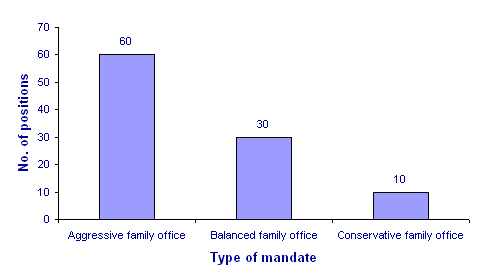Alt Investments
Family Offices Refine Hedge Fund Strategies

Poor returns and the high fees associated with funds of hedge funds are encouraging European family offices to look for alternatives to thei...
Poor returns and the high fees associated with funds of hedge
funds are encouraging European family offices to look for
alternatives to their alternative strategies. In fact, they are
reducing their allocations to FOHF and looking for more exciting
ways to gain hedge exposure. Generally speaking, the family
office flavour of the month is now high-volatility, high-return
single manager hedge funds in niche sectors and geographies.
Families are also looking for funds with less than $500 million
in assets under management so that the office can foster a
key-client relationship with the underlying manager. These are
some of the findings from recent
Scorpio Partnership research into trends in hedge fund
investment by 53 family offices based in Switzerland and the UK.
This showed that equity long-short remains the dominant hedge
fund style, but that global macro and event driven styles are
becoming more attractive to offices looking for new fund managers
with a higher potential to generate alpha returns. And in place
of the diversification that comes through FOHFs, families are
achieving this through holding larger numbers of single hedge
fund manager positions. Interestingly, the number of single
manager positions held appears to vary with the office’s
investment mandate. The more aggressive the mandate, the higher
the number of positions held—and the greater the actual
diversification. Although this seems unintuitive, it can be
explained by the high attrition rate among smaller, niche hedge
funds.
Number of positions in single manager hedge funds

Consistent with the appetite for larger numbers of holdings, a
sizeable number of family offices are launching their own
internally-managed FOHFs. More are also launching in-house single
manager hedge funds, provided they have an investment edge and
the strategy looks viable. In both cases, the commercial motive
is significant. There is a clear trend in Europe for family
offices to spread costs and build critical mass in managed assets
by opening up funds and broader services to other families or
ultra-high net worth individuals. This follows a pattern that has
already become well-established in the US. Unfortunately,
although the spirit may be willing when it comes to large numbers
of single hedge fund investments, in the case of family offices
the flesh is not always able. Family offices are notoriously
thinly staffed and they have traditionally relied on private
networks of contacts to identify new managers and investment
ideas. The acquisition of unique market knowledge becomes
difficult as the universe of hedge funds grows in size and
geographical distribution. As a result, offices are increasingly
turning to specialist hedge fund marketers as a source of
intelligence or, where the office has internal hedge fund
management capabilities, to prime brokers. Indeed, nearly 20 per
cent of the family offices indicated they use independent
external service providers for hedge fund research and even
portfolio construction. FOHF managers need not panic yet,
however. Although the general appetite of family offices for
FOHFs may be declining, there are still some situations where
they will remain an important part of a portfolio — either as a
means of accessing funds that are otherwise closed, or as a way
to assess the investment potential of new sectors and
geographies. And anyway, there may be a trend away from all hedge
funds. The Swiss family offices have a hedge allocation that is
now 15 per cent lower than the UK ones, as they seek new sources
of alpha from assets such as private equity and property.